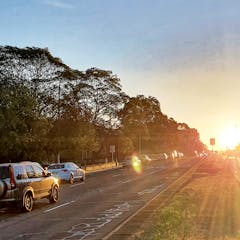
Articles sur Public space
Affichage de 1 à 20 de 113 articles

From lit-up orbs to bland office blocks, cities are full of buildings that people do or do not like. What really shapes how they live – for better or for worse – is urban planning.

China has a lot of vacant retail space, including many underused shopping malls. An urban policy scholar describes how the Chinese are rethinking what the mall is for.

Women are most likely to feel unsafe in their cities or towns, but planning authorities have rarely listened to them. Here’s what we can do to change that.

The way we develop urban peripheries is central to tackling both the housing crisis and the climate emergency.

Diasporic placemaking is often a story of connections and hidden stories. It is also a complicated story about who owns public spaces and who decides who gets to use it.

Ramadan is a time for prayer, charity and kindness to others. Having it celebrated in such a public way is empowering for Muslim communities across the country and beyond.

A systematic review of thousands of studies around the world has found many aspects of our cities affect loneliness. But people’s relationship with their environment is complex and highly individual.

The Hoddle Grid that dictates the flow of vehicles and people in central Melbourne has had its day. It can be remade to reduce the dominance of cars and create a liveable city for the 21st century.

Yi-Fu Tuan, who died in August 2022, was considered the father of humanistic geography. His scholarship on our sense of space and place can tell us a great deal about the challenges we face today.

Organizers across the US are finding innovative grassroots strategies for helping people thrive. Many of these ventures emphasize working together as part of communities and collective systems.

When the pandemic hit, green space was there for us at a time when others weren’t or couldn’t be. Urban greening might be the solution to the ‘lonelygenic environment’ that our cities have created.

Cities are defined as much by their buildings as what people do in between them. Designing them comes with great responsibility.

Scientists and local communities can work together to design interactive play spaces that build math and literacy skills.

Smart street furniture can do a lot of things at once. Some of these functions offer the public clear benefits, but the data collection and surveillance capabilities raise a number of concerns.

The pandemic offered a tantalizing look at city life with fewer cars in the picture. But with traffic rebounding, there’s limited time to lock in policies that make streets more people-friendly.

Roadsides have long been reserved for parking cars, but the pandemic led to many experiments with other ways of using scarce and valuable public space. We can put it to better and more flexible uses.

NSW is developing a comprehensive new planning policy with the goal of creating healthy places. A new study finds those people who work as placemakers want these goals embedded in laws and budgets.

COVID-19 has underscored the value of parks and public spaces. A new survey shows that US mayors have gotten the message, but post-pandemic plans for public spaces remain largely undefined.

Many people prefer the status quo as they struggle to imagine the alternatives. The pandemic has been the catalyst for urban experiments that have opened our eyes to new possibilities.

Facebook’s choice of profits over the people is difficult to reconcile with its commitment to free speech.
